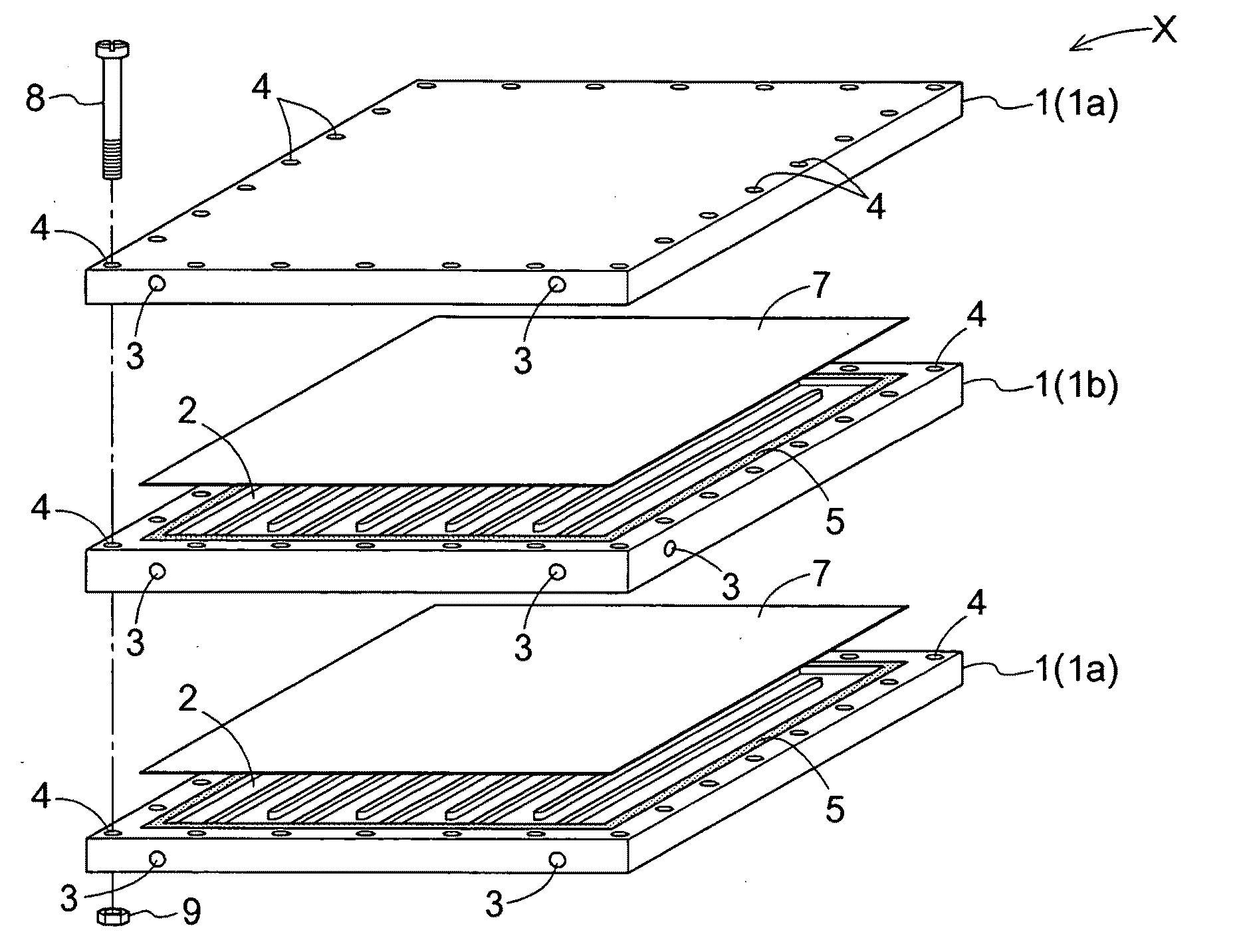Pore Diffusion Type Flat Membrane Separating Apparatus, Flat Membrane Concentrating Apparatus, Regenerated Cellulose Porous Membrane for Pore Diffusion, and Method of Non-Destructive Inspection of Flat Membrane
a technology of pore diffusion and separating apparatus, which is applied in the field of porous membranes, can solve the problems of inability to fully realize the effect of pore diffusion, reduce the influence of interfacial change of membranes, and facilitate the regeneration of membranes
- Summary
- Abstract
- Description
- Claims
- Application Information
AI Technical Summary
Benefits of technology
Problems solved by technology
Method used
Image
Examples
example 1
[0228]A flat plate-like support 1 formed of a polycarbonate plate (referred to as “support” hereinafter) is formed like a flat plate having a plate thickness of about 0.6 cm, a length of 40 cm and a width of 50 cm. And, in one or both faces thereof, there is formed a concave flow conduit 2 having a width of about 1.5 cm and a depth of 0.1 cm, the conduit 2 being in communication with a water conduit 3 from its inlet 3a to its outlet 3b.
[0229]The water conduit 3 functions as entrance / exit for the treatment liquid. In a lateral face of the support 1, there are formed holes having a diameter of about 0.4 cm from the leading end to the terminal end of the flow conduit 2 to be continuous therewith. This ensures flow of the treated liquid along a predetermined direction.
[0230]The thread holes 4 are formed with an inter-hole spacing of 5 cm. And, these are formed directly in the support 1. Then, screws 8 are inserted into them to fix the support 1. The screws 8 need not provide the fixati...
example 2
[0250]FIG. 4 is a view schematically showing a flat membrane concentration apparatus Y. The flat membrane concentration apparatus Y comprises an alternatively superposed assembly of supports 1 and flat membranes 7. The atmospheric pressure is applied to the outer support 1a, thus increasing the close contact between the supports and increasing the packing effect.
[0251]FIG. 5 is a schematic vertical section of the flat membrane concentration apparatus Y. The dot line shown represents omission of a plurality of supports and flat members bound between, from the illustration. In this, a space 10 between the outer disposed support 1a and the flat membrane 7 is under a depressurized condition whereas a space 11 is under a pressurized condition. The support on the pressurized side too defines a flow conduit, which flow conduit facilitates collection of concentrated liquid and allows reverse washing, if necessary.
[0252]As to the support 1b and flat member 7 disposed intermediate in FIG. 5, ...
example 3
[0279]Degassing and filtration were carried out for a solution in which cellulose acetate (average polymerization degree 210) having an average substitution degree of 2.50 was dissolved in a weight concentration (weight concentration in the flow casting stock solution) of 11.5% and a solution prepared with acetone: 51.6% in weight, methanol: 6.5% in weight, CaCl2.2H2O: 1.2% in weight, cyclohexanol: 29.2% in weight, respectively.
[0280]Flow casting was effected on the glass plate to a flow casting thickness of 1 mm. Then, this was kept at 25° C. for 30 minutes to allow a micro-phase separation to occur. Thereafter, this was submerged together with the glass plate in methanol at 25° C., to stop further progress of the micro-phase separation. Then, components remaining in the membrane after the phase separation were eliminated by washing with purified water. This was submerged in 25° C. water adjusted to pH=12.0 with caustic soda to allow a saponification reaction to take place.
[0281]Th...
PUM
| Property | Measurement | Unit |
|---|---|---|
| pore diameter | aaaaa | aaaaa |
| pore diameter | aaaaa | aaaaa |
| thickness | aaaaa | aaaaa |
Abstract
Description
Claims
Application Information
 Login to View More
Login to View More - R&D
- Intellectual Property
- Life Sciences
- Materials
- Tech Scout
- Unparalleled Data Quality
- Higher Quality Content
- 60% Fewer Hallucinations
Browse by: Latest US Patents, China's latest patents, Technical Efficacy Thesaurus, Application Domain, Technology Topic, Popular Technical Reports.
© 2025 PatSnap. All rights reserved.Legal|Privacy policy|Modern Slavery Act Transparency Statement|Sitemap|About US| Contact US: help@patsnap.com



